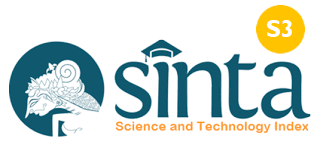Pengembangan Web Interaktif "Hai Si IPA" Untuk Meningkatkan Literasi Sains Di Sekolah Dasar
DOI:
https://doi.org/10.37329/cetta.v6i4.2818Keywords:
Teaching Materials, Primary Education, Blogs, ScienceAbstract
The key to students facing challenges in the 21st century is insight and skills in science literacy. In Indonesian elementary schools, it is noted that students' science literacy is still not maximally utilizing digital technology to learn science and science learning outcomes are still low. Based on the results of observations and interviews in elementary schools, it was found that blog teaching materials had never been used on ecosystem material, so the researcher's goal was to develop a blog teaching material "Hi Si IPA to improve the science literacy of grade V elementary school students. This research uses the ADDIE model (Analysis- Design- Development -Implement -Evaluate). Quantitative data analysis in the form of numbers from the results of expert validation of teaching materials, questionnaires of attractiveness, practicality, effectiveness, namely pretests and posttests. While qualitative data analysis is in the form of criticism and suggestions by teaching material experts, teachers, and students. The results of teaching material expert validation are 81% with very valid criteria. The trial of the "Hi Si IPA" blog in a small group of 5 students with a questionnaire of students' initial knowledge and a pretest questionnaire the results were low, while the results of the student interest questionnaire were 89% with very interesting criteria. The field trial was 25 students in class V, the results of the student and teacher practicality questionnaire were 88.5%. Analysis of the increase in science literacy using the normality gain test from the pretest and posttest results of students was found to increase 84% with high criteria. So that the blog "Hi Si IPA" is feasible to use, attracts students' interest, is practical for learning, and can improve science literacy.
References
Andrian, Yusuf & Rusman. (2019). Implementasi Pembelajaran Abad 21 Dalam Kurikulum Merdeka. Jurnal Penelitian Ilmu Pendidikan, 12(1), 14-23.
Akbar, S. (2015). Instrumen Perangkat Pembelajaran. Bandung: Remaja Rosda Karya.
Arikunto, S. (2010). Prosedur Penelitian: Suatu Pendekatan Praktik. Jakarta: Rineka Cipta.
Branch, Robert. (2009). Instructional Design The ADDIE Approach. USA: Springer. Cahyadi, RAH. (2019). Pengembangan Bahan Ajar Berbasis Addie Model. Halaqa: Islami Education Journal, 3(1), 35-43.
Cahyadi, RAH. 2019. Pengembangan Bahan Ajar Berbasis Addie Model. Halaqa: Islami Education Journal, 3(1), 35-43.
Dikdasmen. (2008). Panduan Pengembangan Bahan Ajar. Jakarta: Ditjen Dikdasmen.
Fadillah, E. (2017). Development Of Assessment Instruments To Measure The Science Process Skills Of High School Students. Didaktika Biologi, 1(2), 123–134.
Fitri, Siti Fidia Nurul. (2021). Problematika Kualitas Pendidikan di Indonesia. Jurnal Pendidikan Tambusai, 5(1), 1617-1620. ISSN: 2614-3097.
Hasdi, & Agustina. (2016). Pengembangan Buku Ajar Geografi Desa-Kota Menggunakan Model Addie. EDUCATIO: Jurnal Ilmu Pendidikan, 11(1), 90-105.
Kemendikbud. (2017). Materi Pendukung Literasi Sains. Jakarta: Direktorat Jenderal Pendidikan Dasar dan Menengah, Kementerian Pendidikan dan Kebudayaan.
Kosasih. (2021). Pengembangan Bahan Ajar. Jakarta: PT Bumi Aksara.
Laila, Azwani Panjaitan. (2021).Pengembangan Literasi Sains di Sekolah. Bogor: Guepedia Publisher.
Mardhiyah, Rifa Hanifa. (2021). Pentingnya Keterampilan Belajar di Abad 21 sebagai Tuntutan dalam Pengembangan Sumber Daya Manusia. Lectura: Jurnal Pendidikan. 12(1), 29-40.
Magdalena, dkk. (2020). Analisis Bahan Ajar. Jurnal Nusantara: Jurnal Pendidikan dan Ilmu Sosial, 2(2), 311-326.
Nasruddin, dkk. (2022). Pengembangan Bahan Ajar. Sumatera Barat: PT Global Eksekuitf Teknologi Redaksi.
Pakpahan, Andrew Fernando, dkk. (2020). Pengembangan Media Pembelajaran. Medan: Yayasan Kita Menulis.
Palupi, dkk. (2020). Peningkatan Literasi Di Sekolah Dasar. Madiun: CV. Bayfa Cendekia Indonesia.
Rusmayana, Taufik. (2021). Model Pembelajaran Addie Integrasi Pedati Di Smk Pgri Karisma Bangsa Sebagai Pengganti Praktek Kerja Lapangan Dimasa Pandemi Covid-19. Bandung: CV. Widina Media Utama.
Rusdi, Muhammad, (2018). Penelitian Desain dan Pengembangan Kependidikan. Depok: PT. Raja Grafindo Persada.
Setiawan & Sudigdo. (2019). Penguatan Literasi Siswa Sekolah Dasar Melalui Kunjungan Perpustakaan. Prosiding Seminar Nasional PGSD UST, 1, 24-30. ISBN 978-602-6258-11-3.
Setyosari, Punjabi. (2015). Metode Penelitian Pendidikan dan Pengembangan Edisi Keempat. Jakarta: Prenada Media Group.
Sugihartini, & Yudiana. (2018). Addie Sebagai Model Pengembangan Media Instruksional Edukatif. Jurnal Pendidikan Teknologi dan Kejuruan, 15(2), 277-286.
Sugiyono. (2011). Metode Penelitian Kuantitatif Kualitatif dan R&D. Bandung: Alfabeta.
Tegeh, I Made & Kirna. (2013). Pengembangan Bahan Ajar Metode Penelitian Pendidikan Dengan Addie Model. Jurnal IKA, 11(1), 12-26.
Yuliati, Yuyu. (2017). Literasi Sains Dalam Pembelajaran Ipa. Jurnal Cakrawala Pendas, 3(2), 21-28.
Utami, Noviyani & Atmojo. (2021). Analisis Kebutuhan Bahan Ajar Digital dalam Pembelajaran IPA di Sekolah Dasar. Jurnal Basicedu, 5 (6), 6300 -6306.
Widyaningtyas, Reviandari & Rika. (2021). Pengantar Kuliah Pengembangan Bahan Ajar. http://elearning.unla.ac.id/mod/resource/view.php?id=2464.
Wisudawati, Asih Widi & Eka Sulistyowati. (2014). Metodologi Pembelajaran IPA. Jakarta: Bumi Aksara
Downloads
Published
How to Cite
Issue
Section
License
Copyright (c) 2023 Dini Rosyada Mahmud, Arif Hidayat, Munzil Munzil, Muhibuddin Fadhli

This work is licensed under a Creative Commons Attribution-ShareAlike 4.0 International License.
An author who publishes in the Cetta : Jurnal Ilmu Pendidikan agrees to the following terms:
- Author retains the copyright and grants the journal the right of first publication of the work simultaneously licensed under the Creative Commons Attribution-ShareAlike 4.0 License that allows others to share the work with an acknowledgement of the work's authorship and initial publication in this journal
- Author is able to enter into separate, additional contractual arrangements for the non-exclusive distribution of the journal's published version of the work (e.g., post it to an institutional repository or publish it in a book) with the acknowledgement of its initial publication in this journal.
- Author is permitted and encouraged to post his/her work online (e.g., in institutional repositories or on their website) prior to and during the submission process, as it can lead to productive exchanges, as well as earlier and greater citation of the published work (See The Effect of Open Access).
Read more about the Creative Commons Attribution-ShareAlike 4.0 Licence here: https://creativecommons.org/licenses/by-sa/4.0/.





